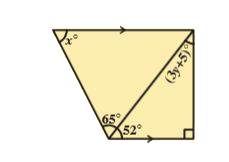When we apply an external magnetising field to a material , what will be the resultant magnetic field inside it ? Solution in Tamil
Resultant field = external field + field material
B=μ0H+μ0M
Topper's Solved these Questions
- BOOK - NEW JOYTHI PUBLICATIONCHAPTER - MAGNETISM AND MATTEREXERCISE - CONTINUOUS EVALUATION(PROJECT)1videos
MAGNETISM AND MATTER
- BOOK - NEW JOYTHI PUBLICATIONCHAPTER - MAGNETISM AND MATTEREXERCISE - CONTINUOUS EVALUATION(ASSIGNMENT)7videos
MAGNETISM AND MATTER
- BOOK - NEW JOYTHI PUBLICATIONCHAPTER - MAGNETISM AND MATTEREXERCISE - PRACTICE PROBLEMS FOR SELF ASSESSMENT12videos
MAGNETISM AND MATTER
- BOOK - NEW JOYTHI PUBLICATIONCHAPTER - ELECTROSTATIC POTENTIAL AND CAPACITANCEEXERCISE - Competitive Exam Corner22videos
ELECTROSTATIC POTENTIAL AND CAPACITANCE
- BOOK - NEW JOYTHI PUBLICATIONCHAPTER - MOVING CHARGES AND MAGNETISMEXERCISE - COMPETITIVE EXAM CORNER28videos
MOVING CHARGES AND MAGNETISM
Similar Questions
Construction of a buzzer, using electromagnet.
02:46View SolutionDiscuss the various types of magnets .
View SolutionThe magnetic moment is 5Am2 and the pole strength is 25 A.m What is the length of the magnet ?
02:18View SolutionFrom the figure find x and y.
 03:08View Solution
03:08View SolutionA solenoid has core of a material with relative permeability 500 and its windings carry a current of 1 A. The number of turns of the solenoid is 500 per metre. The magnetization of the material is nearly
02:47View SolutionA paramagnetic sample shows a net magnetisation of 8Am−1 when placed in an external magnetic field of 0⋅6T at a temperature of 4K. When the same sample is placed in an external magnetic field of 0⋅2T at a temperature of 16K, the magnetisation will be
02:23View SolutionWhen a small magnetising field H is applied to a magnetic material, the intensity of magnetisation is proportional to:
04:52View SolutionWhen a small magnetising field H is applied to a magnetic material the intensity of magnetisation (I) is proportional to:
02:17View Solutionवह पदार्थ जो किसी चुम्बकीय क्षेत्र में रखने पर चुम्बकीय क्षेत्र के विपरीत क्षीण चुम्बकन (magnetisation) प्राप्त कर लेता है, है -
01:34View Solutionवह कौन-सा चुम्बकीय पदार्थ है जो बाह्य चुम्बकीय क्षेत्र का विरोध करता है ?
02:39View SolutionA paramagnetic sample shows a net magnetisation of 8 m^(-1) when palced in an external magnetic field of is placed in an external magnetic field of 0.2 at a temperature of 16 k the magnetisation will be
02:42View SolutionA paramagnetic sample shows a net magnetisation of 8Am−1 when placed in an external magnetic field of 0⋅6T at a temperature of 4K. When the same sample is placed in an external magnetic field of 0⋅2T at a temperature of 16K, the magnetisation will be
03:35View SolutionA paramagnetic sample shows a net magnetisation of 8Am−1 when placed in an external magnetic field of 0⋅6T at a temperature of 4K. When the same sample is placed in an external magnetic field of 0⋅2T at a temperature of 16K, the magnetisation will be
02:18View SolutionA magnetising field intensity of 10Am−1 is applied on a sample of paramagnetic material of susceptibility 1999. The net magnetic field inside the material is
01:48View SolutionA magnetising field intensity of 10Am−1 is applied on a sample of ferromagnetic material of susceptibility 1999.The net magnetic field inside the material is
View Solution

